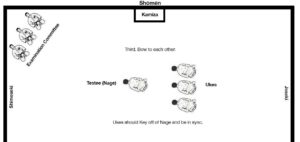 In Aikido, Hakamas generally are associated with ‘Yudansha’ or Black Belt Ranks. In the United States Aikido Federation, especially at major seminars, you will only see Black Belts in Hakamas. It is a sign of experience. It is a symbol of proficiency in your nage skills but more so in your ukemi skills. And when you have have the privilege of wearing one there are some things you need to understand:
In Aikido, Hakamas generally are associated with ‘Yudansha’ or Black Belt Ranks. In the United States Aikido Federation, especially at major seminars, you will only see Black Belts in Hakamas. It is a sign of experience. It is a symbol of proficiency in your nage skills but more so in your ukemi skills. And when you have have the privilege of wearing one there are some things you need to understand:
1. It is very much a part of Aikido tradition and Japanese Garb.
2. You will need to learn how to wear it properly, get comfortable moving in it, folding it, etc.
3. In our organization the only 2 acceptable colors are Indigo (Blue) and Black. You will find most of the senior instructors in the USAF wearing the Indigo color.
Now, you may find some women wearing hakamas prior to black belt but that is more of hygiene decision not a rank one. In most cases, the dedicated women do not want to be treated differently than the men so they opt to not wear a hakama until Shodan.
In some dojos and ours, the Chief Instructor and Dojo Cho will implement an ‘In-House Hakama’ policy. Usually at 1st Kyu, some dojos at 2nd Kyu and some at 3rd Kyu. Let me touch on this for a moment as it pertains to our dojo.
Upon passing your 2nd Kyu test, you are elgible to be asked to wear a hakama in the dojo only. This isn’t automatic. There are several things the senior instructors look at first before making that invitation and it’s not a matter of all the criteria is met but some of it. It’s completely subjective and based exclusively on Main Sensei & Weiner Sensei’s decision.
1. If you have superior ukemi skills, meaning, you can hang with the Black Belts in Class. Your falling is proficient meaning you can most likely protect yourself, take advanced ukemi such as break-falls, etc.
2. You are a serious student. A serious student means you train 4-5 times a week every week averaging 4 classes.
3. You have taken the initiative with your Sempai and Sensei and have learned to fold hakamas.
4. Your Etiquette overall in the dojo is among the best. You always have that mindset.
5. You may be in a Kyu teaching role. (This is based on if there’s a need, for example, when I was a 1st Kyu, we had 4-5 teaching Black Belts but when Weiner Sensei was a 2nd Kyu, there were only 2 so he often taught a Sunday class at that time)
Lastly, if you are a Yukyusha, be patient, if and when you are invited to wear a hakama, embrace it. It’s good practice to learn in the dojo early on how to wear it, tie it, fold it so when you become a Black Belt you have some experience. I’m sure that is why we have this program in place. Never ask to wear one. That is extremely bad etiquette just like asking to be tested is. Your teachers know where you are on your journey and time will allow you the progress you need.
5 Questions with our Chief Instructor – Part 2
5 Questions with our Chief Instructor – Part 2 Jared Heintz: Aikido is often praised for its applicability in self-defense situations. Could you discuss how Aikido techniques can be adapted to real-world scenarios, and what mindset one should cultivate in such situations? Weiner Sensei: As I approach 25 years of Aikido practice, I’ve realized that…
Rank Testing Bowing Reiho – Advanced
Rank Testing Bowing Reiho – Advanced Andy Demko Shihan likes to say, “The little things don’t mean a lot, they mean everything”. Everyone who has practiced in our dojo or visited has seen that we take Reiho (Etiquette) pretty seriously. In all that we do, practice. Bowing. Addressing each other & more. I learned a…
Sensei
Sensei 先生 The two characters that make up the term can be directly translated as “born before,” and imply one who teaches based on wisdom gained from age and experience. In general usage, it is used, with proper form, after a person’s name and means “teacher.” In Japan, the word is also used as a…



